
Zhawar is an area within the Khost Province of Afghanistan. [lower-alpha 1]

Zhawar is an area within the Khost Province of Afghanistan. [lower-alpha 1]
Jalaluddin Haqqani was known by Afghani mujahideen as master of the Zhawar Kili cave complex. [2]
Mir Bahmanyar writes of the caves during 1986. He states there were caves carved into the rock face on the side facing Pakistan. The caves were ten metres long at the maximum, four metres wide and three metres tall. The cave sides had walls of brick. Altogether there were forty-one caves. The caves had doors of iron painted over with bright colours. All the caves were fitted with electrical power. [3]
Zhawar Kili is suspected to have been an area where al Qaeda fighters regrouped after the bombardment of Tora Bora and is located at 33.148792 N, 69.912658 E.
The Zhawar Kili al Badr training camp was based here during 2002. [2]
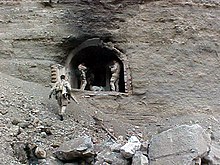

A statement published January 2002, showing the report of the deputy director of operations for the Joint Chiefs of Staff at the time, stated the site was a very large complex (approximately 4.8 by 4.8 kilometres square roughly). [4] [5] Rear Adm. J.D. Stufflebeem stated of the Zhawar Kili al Badr training camp, that it contained at least sixty buildings and caves of a number greater than fifty. [6]
January 2002 saw the insertion of a supported Navy Seals team, who were positioned to perform reconnaissance. Upon discovering a complex of approximately seventy caves converted to facilities for ordnance, they instead proceeded to perform the destruction of this. At the location the men also found classrooms, rooms for cooking, quarters for sleep, and offices, which were constructed using bricks, concrete and steel beams. [7]
The location is the site of a suspected Taliban or al Qaeda base that was bombed in 1998 and 2001. [8] [9]
American cruise missiles bombed a suspected al Qaeda site in Zhawar Kili in 1998 in retaliation for the bombing of the American Embassies in Kenya and Tanzania in 1998. [8]
The United States Air Force performed bombings during 2001. [10] A bombing during November 2001, was indirectly caused by Richard A. Beck, a geologist at the University of Cincinnati who informed the Department of Defense he could identify the rocks showing within video footage of Osama bin Laden released during October 2001, from a field trip he had made to Khowst. Ascertainment of the location was facilitated by the utilization of GIS technology and remote sensing. [8] [11]
During 2002, a period of bombing began, apparently, during the 3rd of January, [12] and included a period from the 6th to the 14th of January 2002. [13] The United States (of America) Department of Defense released a video of the bombardment of Zhawar Kili during March 2002. [14] [15] [16]

Tora Bora is a cave complex, part of the Spin Ghar mountain range of eastern Afghanistan. It is situated in the Pachir Aw Agam District of Nangarhar, approximately 50 kilometres west of the Khyber Pass and 10 km (6 mi) north of the border of the Khyber Pakhtunkhwa province in Pakistan. Tora Bora and the surrounding Spin Ghar range had natural caverns formed by streams eating into the limestone, that had later been expanded into a CIA-financed complex built for the Afghan mujahideen. Tora Bora was known to be a stronghold location of the Afghan mujahideen, used by military forces against the Soviet Union during the 1980s.

Operation Anaconda or the Battle of Shah-i-Kot was a military operation that took place in early March 2002 as part of the War in Afghanistan. CIA paramilitary officers, working with their allies, attempted to destroy al-Qaeda and Taliban forces. The operation took place in the Shah-i-Kot Valley and Arma Mountains southeast of Zormat. This operation was the first large-scale battle in the post-2001 War in Afghanistan since the Battle of Tora Bora in December 2001. This was the first operation in the Afghanistan theater to involve a large number of U.S. forces participating in direct combat activities.
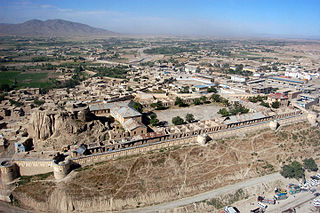
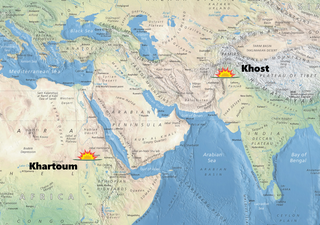
Operation Infinite Reach was the codename for American cruise missile strikes on al-Qaeda bases that were launched concurrently across two continents on 20 August 1998. Launched by the U.S. Navy, the strikes hit the al-Shifa pharmaceutical factory in Khartoum, Sudan, and a camp in Khost Province, Afghanistan, in retaliation for al-Qaeda's August 7 bombings of American embassies in Kenya and Tanzania, which killed 224 people and injured over 4,000 others. Operation Infinite Reach was the first time the United States acknowledged a preemptive strike against a violent non-state actor.
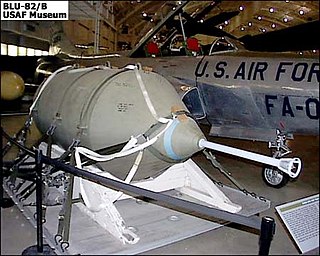
The BLU-82B/C-130 weapon system, known under program "Commando Vault" and nicknamed "Daisy Cutter" in Vietnam for its ability to flatten a section of forest into a helicopter landing zone, is an American 15,000-pound (6,800 kg) conventional bomb, delivered from either a C-130 or MC-130 transport aircraft or a CH-54 heavy-lift "Skycrane" helicopter from the 1st Air Cavalry. A total of 225 were constructed. It was successfully used during military operations in Vietnam, the Gulf War and Afghanistan. The BLU-82 was retired in 2008 and replaced with the more powerful GBU-43/B MOAB.
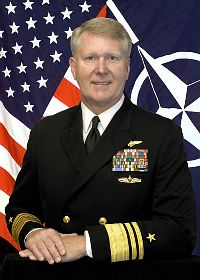
John Dickson "Boomer" Stufflebeem is a former United States Navy vice admiral who last served in that rank as the director of Navy Staff. Stufflebeem served 39 years in the Navy and is well known for his football career and television briefings from the Pentagon following the attacks of 9/11 and subsequent military operations in Afghanistan. He is the Senior Vice President and founder of the NJS Group, LLC, a company specializing in strategic communications and planning as well as crisis management.

Shortly after the September 11 attacks, the United States declared the beginning of the war on terror and subsequently led a multinational invasion of Taliban-ruled Afghanistan. The stated goal was to dismantle al-Qaeda, which had executed the attacks under the leadership of Osama bin Laden, and to deny Islamist militants a safe base of operations in Afghanistan by toppling the Taliban government. The United Kingdom was a key ally of the United States, offering support for military action from the start of the invasion preparations. The American military presence in Afghanistan greatly bolstered the Northern Alliance, which had been locked in a losing fight with the Taliban during the Afghan Civil War. Prior to the beginning of the United States' war effort, the Taliban had seized around 85% of Afghanistan's territory as well as the capital city of Kabul, effectively confining the Northern Alliance to Badakhshan Province and smaller surrounding areas. The American-led invasion in October 2001 marked the first phase of what would become the 20-year-long War in Afghanistan.
Abib Sarajuddin is a citizen of Afghanistan, who was held in extrajudicial detention in the United States Guantanamo Bay detention camps, in Cuba. His Guantanamo Internment Serial Number was 458. Guantanamo intelligence analysts estimate that he was born in 1942.
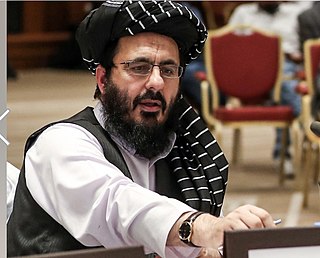
Mawlawi Mohammad Nabi Omari is a citizen of Afghanistan who was held for nearly twelve years in extrajudicial detention in the United States Guantanamo Bay detainment camps, in Cuba. His Guantanamo Internment Serial Number was 832. American intelligence analysts estimate that he was born in 1968, in Khowst, Afghanistan. He arrived at the Guantanamo detention camps on October 28, 2002.

Jalaluddin Haqqani was an Afghan insurgent commander who founded the Haqqani network, an insurgent group fighting in guerilla warfare against US-led NATO forces and the now former government of Afghanistan they support.

The Battle of Tora Bora was a military engagement that took place in the cave complex of Tora Bora, eastern Afghanistan, from November 30 – December 17, 2001, during the final stages of the United States invasion of Afghanistan. It was launched by the United States and its allies with the objective to capture or kill Osama bin Laden, the founder and leader of the militant organization al-Qaeda. Al-Qaeda and bin Laden were suspected of being responsible for the September 11 attacks three months prior. Tora Bora is located in the Spīn Ghar mountain range near the Khyber Pass. The U.S. stated that al-Qaeda had its headquarters there and that it was bin Laden's location at the time.
American counter-terrorism analysts justified the continued extrajudicial detention of many Guantanamo captives because they were suspected of staying in al-Qaeda safe houses, or guest houses—or because names matching theirs, or their "known alias" were found in the suspect houses.
The Battles of Zhawar were fought during the Soviet–Afghan War between Soviet Army units, and their allies of the Democratic Republic of Afghanistan against Afghan mujahideen groups. The Soviets' objective was to destroy the Mujahideen logistic base situated at Zhawar, 3 kilometers from the Pakistani border.

The Islamic Jihad Union is a militant Islamist organization founded in 2002 as a splinter group of the Islamic Movement of Uzbekistan (IMU). Headquartered in North Waziristan, a mountainous region of northwest Pakistan, bordering Afghanistan, the group has been affiliated with both Al-Qaeda and the Taliban.

Ayman Saeed Abdullah Batarfi is a Yemeni doctor who was held in extrajudicial detention in the United States Guantanamo Bay detention camps, in Cuba. His Guantanamo Internment Serial Number was 627.
Regional and tribal Afghan leaders rose up and formed an alliance known as the Eastern Shura to oust the Taliban in Khowst Province and Nangarhar Province, during the War in Afghanistan. Mary Anne Weaver, writing in The New York Times on the fourth anniversary of al Qaeda's attacks on September 11, 2001, described the formation of the Eastern Shura as the result of surrender negotiations on November 13, 2001, between Mohammad Yunus Khalis and Osama bin Laden.

The Haqqani network is an Afghan Islamist group, built around the family of the same name, that has used asymmetric warfare in Afghanistan to fight against Soviet forces in the 1980s, and US-led NATO forces and the Islamic Republic of Afghanistan government in the 21st century. It is recognized as a terrorist organization by the United Nations. It is considered to be a "semi-autonomous" offshoot of the Taliban. It has been most active in eastern Afghanistan and across the border in north-west Pakistan.
General Kamal Khan Zadran is a member of a prominent family active in Eastern Afghanistan. In 2001 his brother Pacha Khan Zadran was a signatory of the Bonn Conference agreement that chose Hamid Karzai as the President of the Afghan Transitional Authority. In 2002 his brother Amanullah Zadran, defected from the Taliban and was appointed the Minister of Border Affairs and Tribal Affairs, and Pacha Khan was appointed Governor of Paktia Province.
The FirstBattle of Zhawar was fought during the Soviet–Afghan War between Afghan Army units, and their allies the Soviet Union, against mujahideen groups of Haqqani and Khalis. Their objective was to destroy the Mujahideen logistic base situated at Zhawar, 3 kilometers from the Durand line.
The Second Battle of Zhawar was a significant engagement that took place during the Soviet-Afghan War. It pitted Afghan Army units, supported by the Soviet Union, against mujahideen faction led by Jalaluddin Haqqani. The objective of the battle was to destroy the mujahideen's logistical base located in Zhawar, just three kilometers from the Durand Line.